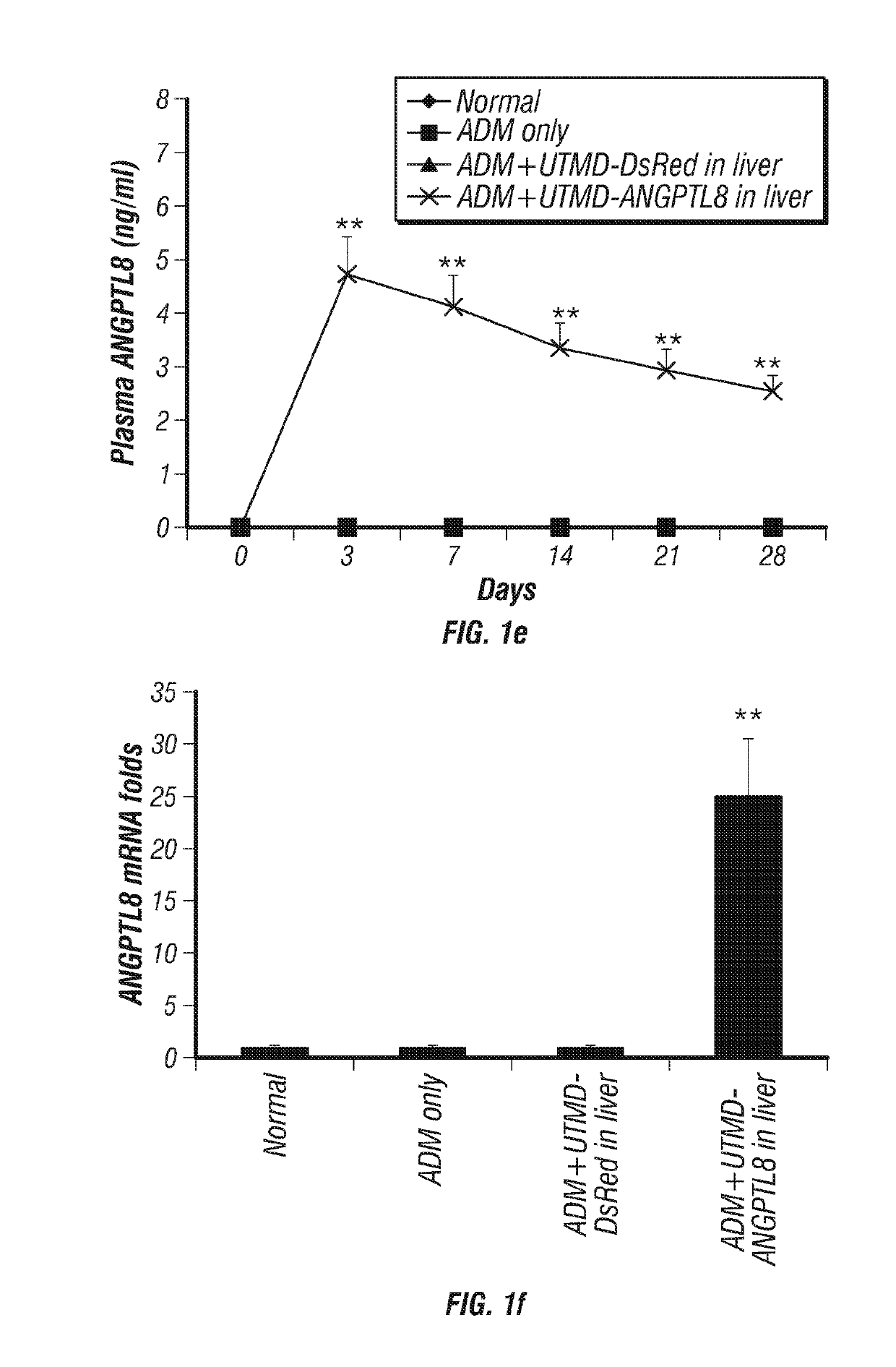Angiopoietin-like protein 8 (angptl8)
an angiopoietin-like protein and angiopoietin-like protein technology, applied in the field of angiopoietin-like protein 8 (angptl8), can solve the problems of small myocardial regeneration triggered by such mechanisms, high cost, and inability to reverse established cardiomyopathy
- Summary
- Abstract
- Description
- Claims
- Application Information
AI Technical Summary
Benefits of technology
Problems solved by technology
Method used
Image
Examples
example 1
Examples of Methods
[0245]Animal Protocols
[0246]Animal studies were performed according to National Institutes of Health (NIH) recommendations and approved by our institutional animal research committee. Adult male Sprague-Dawley rats were purchased from Harlan Laboratories (Indianapolis, Ind., USA).
[0247]The protocol was planned to test the hypothesis that delivery of ANGPTL8 by UTMD could reverse established adriamycin (ADM) cardiomyopathy defined as a fractional shortening <30% by echocardiography after injection of ADM (Iliskovic, et al., 1997) at total dose of 15 mg / kg / ip, 2.5 mg / kg / ip 6 times over 2 weeks.
[0248]Protocol-1 for ANGTPL8 Gene Therapy:
[0249]There were 120 rats divided into three control groups of 30 rats each and a treatment group of 30 rats: (1) normal control rats; (2) ADM injection only; (3) ADM plus UTMD with a DsRed reporter gene (pXL-BASII-CI-DsRed / pCI-hyPB); (4) ADM plus UTMD with ANGPTL8 (pXL-BASII-CI-ANGPTL8 / pCI-hyPB). All rats were euthanized at 3 days, 7 ...
example 2
UTMD Targeting of Human ANGPTL8 Gene to Liver of Rats
[0269]FIG. 1 shows that human ANGPTL8 signal was detected in liver cells after UTMD-pXL-BASII-CI-ANGPTL8 / pCI-hyPB delivered to the liver (FIG. 1d) but was not detected in normal rat liver, nor in the controls treated with Adriamycin (ADM) only and ADM plus UTMD-DsRed reporter gene (FIG. 1a-c). Human ANGPTL8 signal was detected in the cytoplasm of liver cells of rats from 3 days to 4 weeks after delivery of the ANGPTL8 gene to liver by UTMD. FIG. 1e shows fasting plasma levels of human ANGPTL8 in rats. In the normal and DsRed reporter gene control rat groups, no human ANGPTL8 was detected in fasting plasma. However, in the treatment groups, human ANGPTL8 was detected in fasting plasma from day 1 to day 28 after UTMD. Human ANGPTL8 mRNA levels were further evaluated using qRT-PCR. The results (FIG. 1f) showed that human ANGPTL8 mRNA levels after UTMD-ANGPTL8 gene delivery were 25±8 fold greater, respectively, than for the normal, AD...
example 3
Reversal of Established Adriamycin Cardiomyopathy after UTMD-ANGPTL8 Gene Therapy
[0270]Pharmacological effects of ANGPTL8 on rat hearts with established adriamycin cardiomyopathy was characterized. Echocardiography was utilized to evaluate heart structure and function in all groups. FIG. 1h-k demonstrated M-mode images derived from 2D parasternal short axis views of the left ventricle showing decreased LV fractional shortening and LV mass in adriamycin cardiomyopathy with restoration to normal values by UTMD-ANGPTL8 gene therapy (1 and m).
PUM
| Property | Measurement | Unit |
|---|---|---|
| temperature | aaaaa | aaaaa |
| ionic strength | aaaaa | aaaaa |
| temperature | aaaaa | aaaaa |
Abstract
Description
Claims
Application Information
 Login to View More
Login to View More - R&D
- Intellectual Property
- Life Sciences
- Materials
- Tech Scout
- Unparalleled Data Quality
- Higher Quality Content
- 60% Fewer Hallucinations
Browse by: Latest US Patents, China's latest patents, Technical Efficacy Thesaurus, Application Domain, Technology Topic, Popular Technical Reports.
© 2025 PatSnap. All rights reserved.Legal|Privacy policy|Modern Slavery Act Transparency Statement|Sitemap|About US| Contact US: help@patsnap.com



